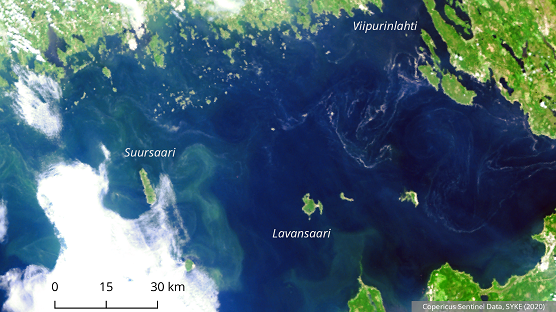Press release 2020-06-18 at 14:10

Wednesday 17th of June Sentinel 3 image from the Gulf of Finland shows cyanobacterial blooms on the surface around Gogland island. The trails visible in front of Vyborg and in the eastern parts of Gulf of Finland are not cyanobacterial blooms, but pollen. The image contains edited Copernicus Sentinel data, SYKE (2020).
During the Midsummer week, cyanobacteria have started to occur in increasing numbers both in lakes and in the southern and southwestern parts of Finnish sea areas. The exceptionally warm weather in June has locally brought forward cyanobacterial occurrences in lakes, while in the Baltic sea areas the situation is typical of the time. On shores, there might still be an abundance of yellowish pollen from coniferous trees, which deceptively resembles cyanobacterial bloom.
Read more in Finnish
Report your algal bloom observations to the Järvi-meriwiki (Lake and sea wiki)
In the Järvi-meriwiki maintained by the Finnish Environment Institute, everyone has the opportunity to establish their own observation site and share algal bloom observations from lakes and coastal areas. Individual observations can also be sent while navigating different water bodies. You can also report observations using the smartphone-friendly Havaintolähetti website. The reported observations are shown on the national algal situation map, and they support the national algal situation assessment. Observations about the absence of cyanobacteria are also important.
Järvi-meriwiki is an online service produced in collaboration with authorities and citizens. The service provides basic information on all lakes larger than one hectare as well as different areas of the Baltic Sea. Users can share, for example, photos and other observations on the service.
Municipalities and cities monitor the cyanobacterial situation on the beaches, so it is advisable to report rich cyanobacterial blooms on beaches to the health authorities of the municipality in question.
Cyanobacteria observations also in the Itämeri.fi service
This summer, a website on algal bloom observations on the Itämeri.fi service is also launched. The cyanobacterial map presented on this algal bloom observations page combines the observations reported to the Järvi-meriwiki and from the beaches of the City of Helsinki as well as the observations based on satellite interpretations of the Finnish Environment Institute during the last three days.
This is how you identify cyanobacteria
A small amount of cyanobacteria in the water appears as green or yellowish particles. Narrow stripes of algae can drift to a beach. In calm weather, a substantial amount of cyanobacteria forms greenish or yellowish algal rafts and piles up in coastal water. Unlike cyanobacteria, pollen is found not only on the surface water but also, for example, on piers or yard furniture.
If the algae dissolve into tiny particles in the water when you touch it with a stick, it may be cyanobacteria. If the algae attache to the stick, it is something other than cyanobacteria. In a glass of water, cyanobacteria rise to the surface as tiny greenish particles within about an hour.
Algae bloom risk analysis
The risk of cyanobacterial blooms in the Finnish sea areas is considerable or moderate – the summer weather determines the actual situation (Press release June 4, 2020)
Information about algae situation
Pictures
Give your opinion on improving the status of waterways!
More information
Due to Midsummer, the experts will be unavailable from 19th of June until 21st of June.
SYKE algal bloom monitoring wishes everyone a Happy Midsummer!
(Telephone 1.00-3.00 pm)
Lakes
- Senior Research Scientist Kristiina Vuorio, Finnish Environment Institute SYKE, Tel. +358 295 251 757, firstname.lastname@ymparisto.fi (until 18.6.)
- Researcher Laura Härkönen, Finnish Environment Institute SYKE, Tel. +358 295 251 009, firstname.lastname@ymparisto.fi (from 22.6.)
Sea areas
Cyanobacterial bloom situation
- Researcher Heidi Hällfors, Finnish Environment Institute SYKE, Tel. +358 295 251 114, firstname.lastname@ymparisto.fi
State of the Baltic Sea
- Senior Research Scientist Jouni Lehtoranta, Finnish Environment Institute SYKE, Tel. +358 295 251 363, firstname.lastname@ymparisto.fi
Communications
- Communications Intern Sini Harvo, Finnish Environment Institute SYKE, Tel +358 295 252 184, firstname.lastname@ymparisto.fi